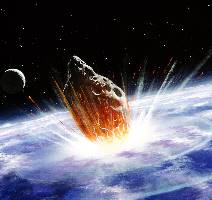Summary
Students will conduct experiments to find the experimental probability of a meteorite landing in water on Earth and will then use area models to create a theoretical probability. Students will compare their values to known estimates of the percentage of the Earth's surface that is covered by water.
Essential Question(s)
What are the different ways to determine the likelihood of an event?
Snapshots
Engage
Students make up a quick story of an asteroid hitting Earth and share their stories.
Explore
Students model the impact of a celestial body hitting Earth and use the model to determine the probability of a water impact by approximating the percent of Earth's surface covered by water.
Explain
Students learn about theoretical and experimental probability and compare them.
Extend
Students use theoretical probability to determine how many meteorites would strike land.
Evaluate
Students write a 2-minute paper about he difference between experimental and theoretical probabilities, including a critique of the strengths and weaknesses of each.
Materials
1 globe for every four students in the class or 1 map for every four students in the class
measuring tools
Calculating Probability Handout (attached)
Engage
Display slide 4. It has the question: "What might happen if a large asteroid strikes Earth?" Tell students to quickly come up with a creative story of when a large asteroid strikes Earth.
On your board or document camera, create a table with three columns. Title one column "land," the next "water," and the final column "both." As students share their stories, document via tally marks if the asteroid hits land, water, or both.
Progress to slide 5. Once the students are all done, ask them if they think the representation of land, water, or both in their stories is equal to the reality of land and water on Earth.
Explore
Put students in groups of four. Pass out the Calculating Probabilities Handout to each student.
Tell them that they are doing Part 1 right now.
Each group needs to design a method to determine the probability that an asteroid colliding with Earth will strike land (and not water). Inform students that they will be able to use maps and/or globes to assist them (but do not pass them out yet). Give the groups time to create a design for their experiment first.
Once students have a plan, give students some time to execute their experiment and collect data.
After students have collected data, they should answer all the questions on the handout for Part 1 to determine the probability of an asteroid hitting land.
Explain
Progress to slide 7. Have students write the definitions of theoretical and experimental probability in their notes notebook (or wherever your students document their notes).
Ask students, based on the definitions, did they calculate experimental or theoretical probability?
Then, have students look at Part 2 of the handout. Tell them to fill out the Venn diagram comparing theoretical and experimental probability.
Extend
Progress to slide 8. Tell students to start on Part 3 of the handout, measuring and calculating the theoretical probability of an asteroid hitting land on Earth. Allow students access to certain tools like rulers so they can measure areas and collect information to perform their calculations.
Evaluate
Have students complete a Two-Minute Paper to answer the prompt "What is the difference between experimental and theoretical probabilities? What are the strengths and weaknesses of each?"
Resources
Impact: Earth! web application (optional to the lesson): Collins, G., Melosh, H. J., & Marcus, R. (2016). Impact: Earth! Purdue University. Retrieved from http://www.purdue.edu/impactearth/


